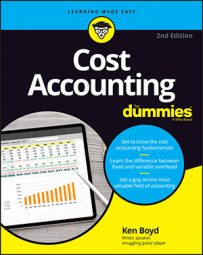Just-in-time (JIT) purchasing is a cost accounting strategy where you purchase the minimum amount of goods to meet customer demand. Say you decide to approach your supplier about moving to a JIT purchasing arrangement. The supplier needs to deliver smaller shipments more frequently. You request a price quote based on new, different levels of purchasing activity. Compare the financial impact of your current purchasing system with a JIT purchasing system.
JIT purchasing costs in cost accounting
Say you manage a large chain of sporting-goods stores. You’re considering the impact of JIT purchasing for many products. At the moment, you’re evaluating baseball bats.
Here’s some information regarding baseball bat purchases:
Purchasing costs: The cost per baseball bat is $100 for both your current purchasing method and JIT purchasing.
Ordering costs: The cost per order is $150 for both purchasing methods.
Opportunity costs: Company management has decided on an 8 percent required rate of return on investment. That 8 percent rate applies to any use of capital, including inventory purchases. This is the minimum return that the company expects from the money it has invested. If this return is not achieved, there are likely better alternatives for the company’s cash.
Average inventory: Average inventory is defined as the average value of inventory during a certain time period. Average inventory is (beginning inventory + ending inventory) ÷ 2. Currently, your average inventory is 10 percent of annual sales, or 2,000 bats. Under JIT, your average inventory will decline to 200 units.
Carrying costs: You also incur costs for insurance and storage. Carrying costs total $15 per unit.
This table compares your current purchasing costs with JIT purchasing costs.
| Total Costs | Current | JIT | ||
|---|---|---|---|---|
| Purchasing costs | Cost | Units | ||
| $100/unit | 20,000 | $2,000,000 | $2,000,000 | |
| Ordering costs | Cost | Orders | ||
| $150/order | 20 | $3,000 | ||
| $150/order | 200 | $30,000 | ||
| Opportunity costs | Cost | Inventory | ||
| 8% rate | $100/unit | 2,000 | $16,000 | |
| 8% rate | $100/unit | 200 | $1,600 | |
| Other carry costs | Cost | Inventory | ||
| $15/unit | 2,000 | $30,000 | ||
| $15/unit | 200 | $3,000 | ||
| Total costs | $2,049,000 | $2,034,600 |
JIT purchasing saves you $14,400 in costs ($2,049,000 current costs less $2,034,600 JIT purchasing costs).
Using JIT purchasing, the number of orders increases from 20 to 200. Purchase ordering costs increase from $3,000 to $30,000.
The opportunity cost multiplies the 8 percent rate x $100 unit cost x the average inventory. Note that the average inventory for your current process is 2,000 units; so, the opportunity cost for your current purchasing system is much higher than with JIT ($16,000 versus $1,600).
Carrying costs are $15 per unit. When you cut the average inventory with JIT, you also reduce carrying costs ($30,000 current versus $3,000 JIT).
JIT stockout costs in cost accounting
Before you decide on JIT purchasing, consider other costs. Stockout costs weren’t included in the table. Those costs are more difficult to quantify.
The financial impact of a stockout is hard to pin down, but you can develop some data. You can probably identify individual stockout situations. Your store managers can track customers who ask for out-of-stock items. The total stockout cost would be the number of customers requesting an out-of-stock product multiplied by the cost you incur to get them the product.
This table shows that the ordering cost is $150 per order. All suppliers give their clients a cost quote for placing small, last-minute orders. Now this is a different cost for a different service.
Say that the minimum cost for any order is $30. As stockouts occur, you place last-minute orders for small amounts — sometimes two bats, sometimes ten. You estimate a stockout cost per item of $5 per bat.
You forecast 50 customer orders placed when bats are out of stock. The total stockout cost would be $5 per unit x 50 orders = $250.
You can’t quantify the opportunity cost of future lost business due to stockouts. Sure, you may be able to “save the order” by ordering the product when it’s out of stock. The customer gets the product, but not as soon as he or she wanted it. That experience may mean that he or she will do business somewhere else going forward.

